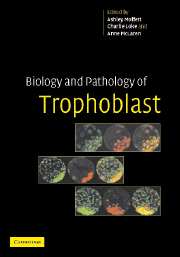Book contents
- Frontmatter
- Contents
- List of contributors
- List of participants
- Preface
- Chair's introduction
- 1 Trophoblast cell fate specification
- 2 Stem cells: pluripotency and extraembryonic differentiation in the mouse
- 3 Epigenetic regulation of trophoblast development
- 4 Regulation of X-chromosome inactivation in relation to lineage allocation in early mouse embryogenesis
- General discussion I
- General discussion II
- Final general discussion
- Index
- Plate section
- References
3 - Epigenetic regulation of trophoblast development
Published online by Cambridge University Press: 07 August 2009
- Frontmatter
- Contents
- List of contributors
- List of participants
- Preface
- Chair's introduction
- 1 Trophoblast cell fate specification
- 2 Stem cells: pluripotency and extraembryonic differentiation in the mouse
- 3 Epigenetic regulation of trophoblast development
- 4 Regulation of X-chromosome inactivation in relation to lineage allocation in early mouse embryogenesis
- General discussion I
- General discussion II
- Final general discussion
- Index
- Plate section
- References
Summary
Trophectoderm is the first differentiated lineage to be established during development. In the mouse, the founder cells for this lineage are set aside early as a result of asynchronous division of eight-cell-stage blastomeres, the outer cells being the founder cells for the trophectoderm lineage while the inner cells form the inner cell mass (Johnson & Ziomek 1981). The pluripotent epiblast cells in the inner cell mass of blastocysts serve as the precursors of the developing fetus. However, some of the key signalling molecules for early development of the pluripotent epiblast cells originate from the trophectoderm and primary endoderm cells (Beddington & Robertson 1999), including the signals for the specification of germ cells (McLaren 1999). The purpose of this review is to focus on the role of epigenetic mechanisms in the establishment of the trophectoderm lineage and the subsequent development of the placenta. In particular we are interested in how the maternally inherited factors in the oocyte affect development of the trophoblast through their effect on epigenetic modifications. Although this aspect requires detailed investigations, there are already indications that the interactions between maternal factors in the oocytes and the parental genomes may be critical for early development, including development of the trophoblast.
Role of genomic imprinting in development of the trophoblast
At the time of fertilisation, the parental genomes are epigenetically non-equivalent, but additional epigenetic modifications ensue in the early zygote (Ferguson-Smith & Surani 2001).
- Type
- Chapter
- Information
- Biology and Pathology of Trophoblast , pp. 33 - 45Publisher: Cambridge University PressPrint publication year: 2006



